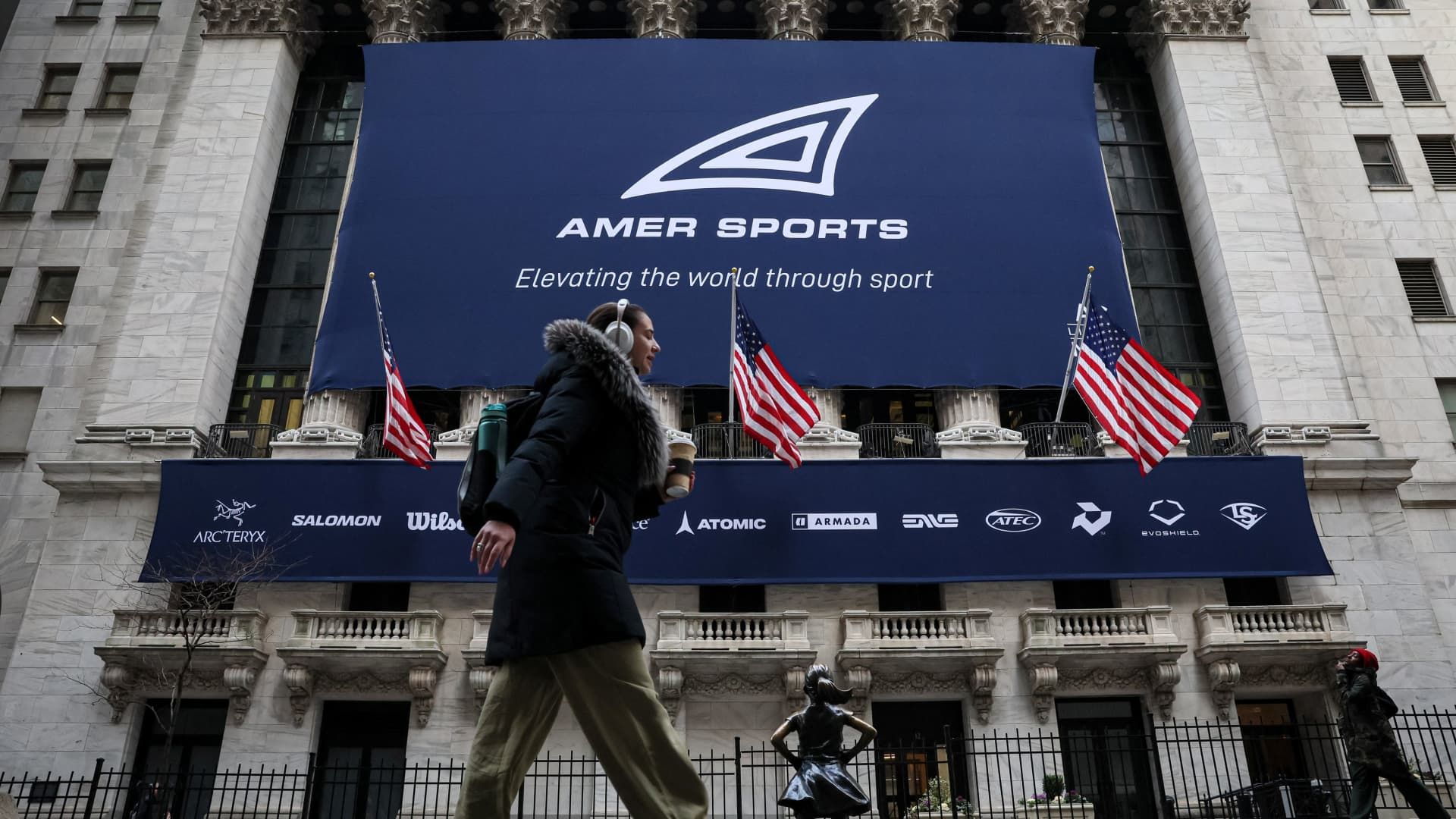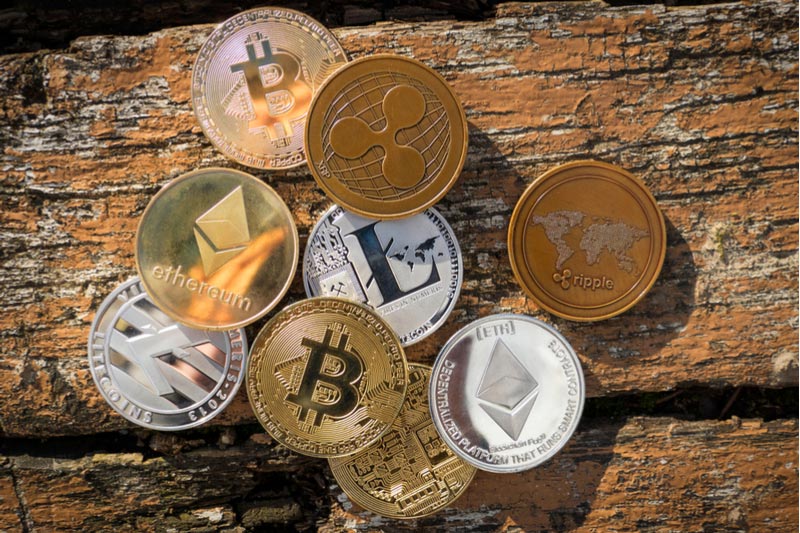Actions of american sportsThe maker of Wilson tennis rackets and Lousiville Slugger baseball bats, fell about 10% on Tuesday after the company reported strong sales in China but a slowdown in wholesale orders.
Here's how the new public sports company fared in its fourth quarter. CNBC did not compare the results to Wall Street estimates because it is the first earnings report since Amer Sports went public.
- Loss per share: 25 cents
- Revenue: $1.32 billion
In the three months ended Dec. 31, the company reported a net loss of $94.9 million, or 25 cents per share, compared with $148.3 million, or 39 cents per share, a year earlier.
Sales rose to $1.32 billion, up about 10% from $1.2 billion a year earlier.
Amer, which also owns Arc'teryx, Salomon and other sports clothing and equipment brands, operates in three distinct business segments. These are technical pieces, including their expensive Arc'teryx winter jackets; outdoor performance, such as Salomon winter sports equipment; and ball and racquet sports, including equipment and apparel from Wilson and Louisville, among others.
During the quarter, Amer's technical apparel sales increased 26% year over year to $550 million, driven by a 42% increase in direct sales. Sales in the segment primarily come from buyers who buy directly from Amer brands rather than wholesale partners.
Outdoor sales rose 2% to $523 million, driven by strength in the segment's winter sports equipment franchise, which was offset by a slowdown in wholesale orders for Salomon footwear.
Sales of balls and rackets declined 3% to $242 million as the segment outperformed tougher comparisons. In the same period a year earlier, retailers were still dealing with supply chain issues and had overordered equipment such as tennis rackets and baseball bats. As they sought to keep their inventory levels in check, some wholesalers pulled orders during the quarter, but Amer expects the segment to level out in the coming quarters and end fiscal 2024 with sales in the low to mid-single digit range. .
The company began trading on the New York Stock Exchange last month under the symbol “AS.” Shares rose just 3% in Amer's public markets debut after it priced its initial public offering at a discount. Sellers showed moderate interest in the stock during its first day of trading over concerns about its connections and exposure to China and its debt-laden balance sheet.
Founded in Helsinki in 1950, Amer was a Finnish public company until a consortium of investors led by China's Anta Sports, FountainVest Partners, Anamered Investments and Tencent privatized it in 2019.
Since the acquisition, sales grew about 45%, from $2.45 billion in 2020 to $3.55 billion in 2022. Revenue rose again in 2023 to $4.37 billion, the company said Tuesday.
Still, Amer failed to turn a profit between 2020 and 2023. In 2023, the company lost $208.8 million, but its losses narrowed from $230.9 million in 2022.
In a statement on Tuesday, Amer CEO James Zheng said the company is still in the “early stages” of its “profitable growth journey.”
“We are winning in the premium segment of the sports and outdoor market, which remains healthy and growing. Driven by our technical performance products, we believe Amer Sports brands resonate strongly with consumers across the world. world, but they are still relatively small players on the global stage,” Zheng said. “Looking ahead, our confidence is bolstered by the fact that our highest-margin brand, region, channel and category are growing faster.”
Much of its expansion has occurred in China. Between 2020 and 2022, Amer increased sales in the region from 8.3% of total revenue to 14.8%. In the nine months ended September 30, almost 20% of sales came from the region. That growth story continued during Amer's fiscal fourth quarter. Sales in greater China increased 45% and all three of the company's segments experienced “solid growth.”
Much of the growth in China came during a time when the region was reopening from the Covid pandemic and some retailers experienced large spikes in demand that may not be sustained over time.
Amer's supply chain is also highly exposed to the region. Most of its products come from suppliers “predominantly” in the Asia-Pacific region, including China, according to a securities filing.
Amer says it is a global company with a diverse reach across countless geographies, but those regions are growing at an uneven pace. In 2023, sales in Europe, the Middle East and Africa accounted for about 33% of total revenue, up from 36% in 2022. North America accounted for about 39.5% of sales in 2023, up from 42.4 % of sales in 2022.
By contrast, China accounted for about 19% of sales in 2023, up from 14.8% in 2022. Sales in Amer's APAC region accounted for 8% of total revenue in 2023, up from 7%. in 2022.
Amer CFO Andrew Page Foot Locker The former CFO told CNBC in an interview that China has seen enormous growth compared to the company's other regions because the market is less mature and it has spent more time growing its presence there. Considering the possibility that demand there is unsustainable, Page said he still sees a “significant runway” in the region.
“I think China will be much more reflective of our controlled growth than a situation where there is no consumer demand,” Page said. “We will monitor our growth and continue to monitor our business regionally and ensure we are growing appropriately in all of our regions.”
He said the company is following China's economic situation “closely,” but that its target consumer in the region tends to be more premium-inclined and tends to be more “resilient” than the general population.
During the fourth quarter, sales in APAC grew 22% and in North America, revenue only increased by a mid-single-digit percentage. The strength of Amer's direct channels boosted sales in the region, but that boost was offset by a slowdown in wholesale revenue.
For its first quarter, Amer expects reported revenue to grow between 6% and 8%, and projects its adjusted gross margin to be around 53.5%. It anticipates earnings to range between a loss per share of 1 cent and earnings per share of 2 cents.
The company expects technical apparel revenue to grow about 30%, sales of its outdoor performance categories to remain stable year over year, and sales of the balls and racquets segment to decline by a double-digit percentage.
For the full year, Amer expects sales to grow by approximately 10% and anticipates an adjusted gross margin of between 53.5% and 54%. It forecasts earnings per share of between 30 cents and 40 cents.
Read the full earnings release here.
Don't miss these CNBC PRO stories:










